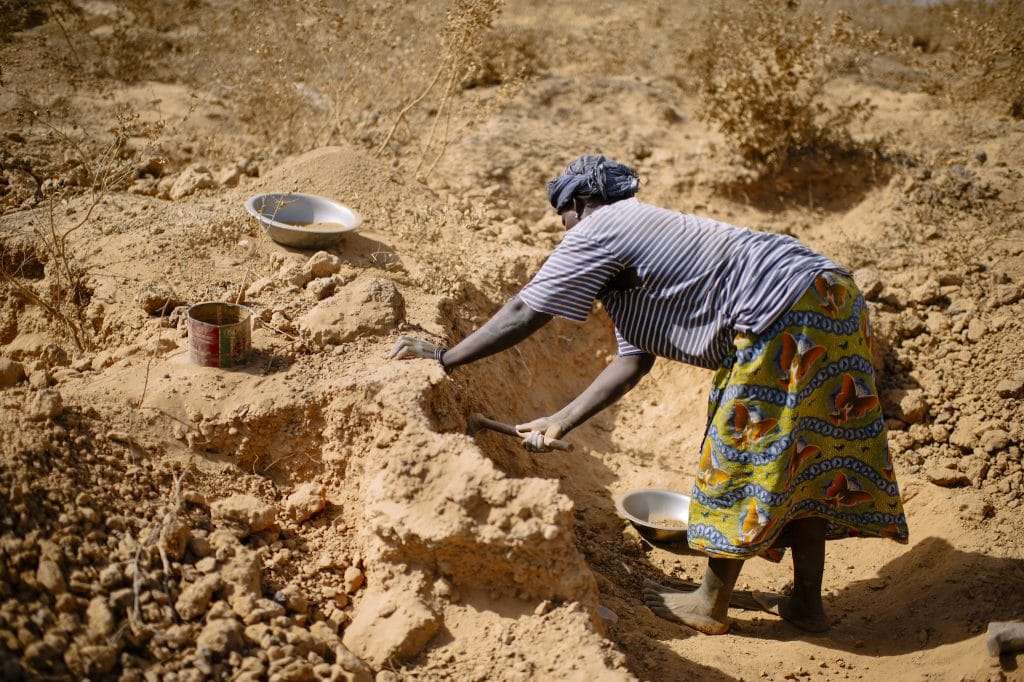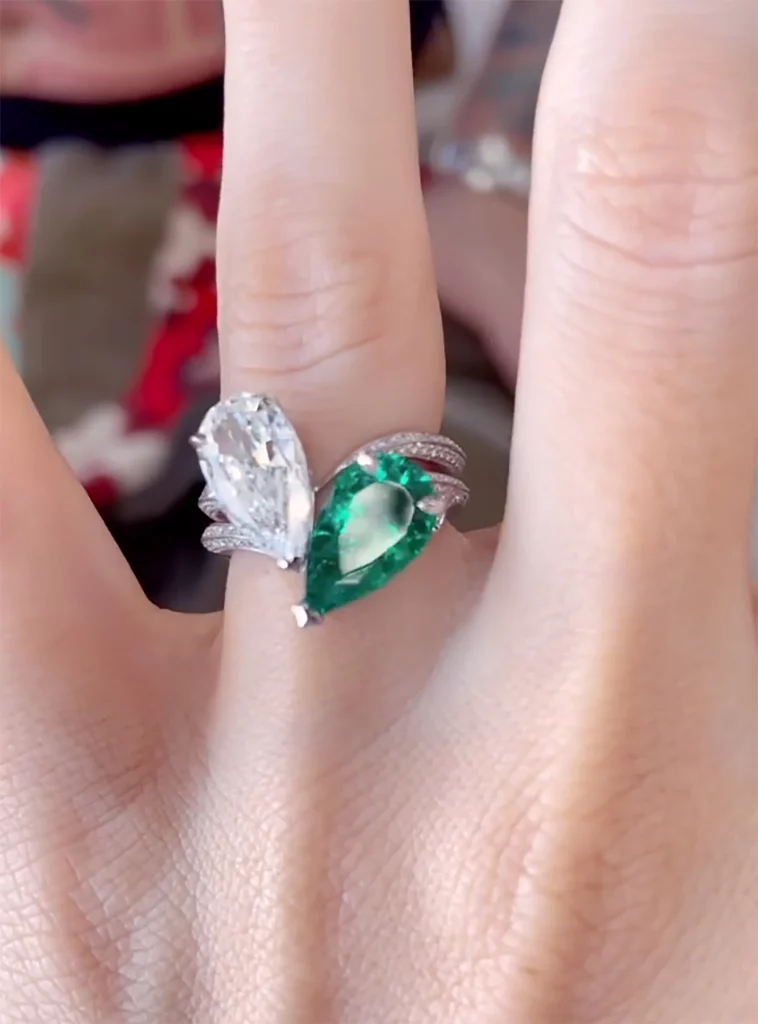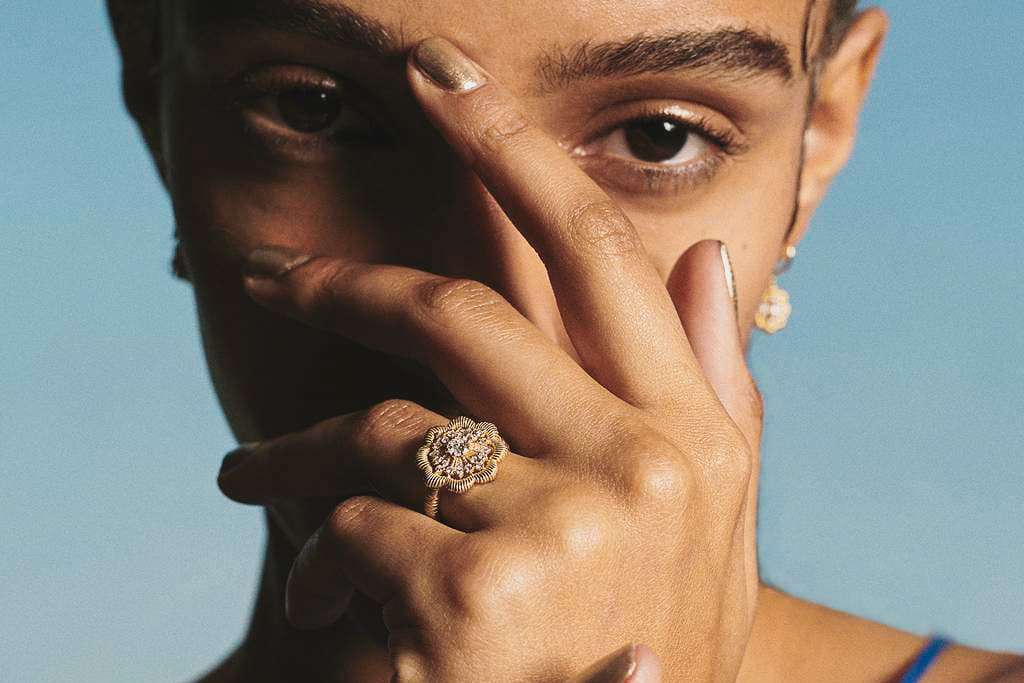Whether responsibly mined or recycled, ethical gold is proving to be the only viable option in the evolving jewelry landscape.
The gold mining industry is complicated. It’s long been compromised by human rights violations and environmental destruction. But it’s also vital to local economies, supporting communities, and, in recent years, becoming an ally in providing resources to protect and preserve land, animals, and waterways. And it’s the impetus behind a certification scheme launched in 2022 aimed at removing mercury and guaranteeing ethically sourced gold from small-scale mines.
Sustainable artisanal and small-scale gold mines
An agreement between SCS Global Services and the Alliance for Responsible Mining (ARM) will expand on the SCS 007 Sustainability Rated Jewelry Standard to include gold that’s sourced from artisanal and small-scale mines around the world (ASM). Gold sourced from qualifying mines will be able to market their products as Certified Sustainability Rated Gold, the companies say.
More than 50 percent of the world’s gold mines are operated unethically, according to Jonathan Gonzalez, ARM market development manager. “The main source of mercury pollution in the world is poor mining activity. When we remove these practices from the artisanal communities, even though their impact is small, it still helps,” he said.

“This agreement represents another important advance for the jewelry industry, bringing state-of-the-art science to the verification of origin, sustainability, and climate claims for ASM-sourced gold,” Gina D’Amato, Executive Director of ARM, said in a statement. “It is one more way that we can support the lives and livelihoods of artisanal and small-scale mining communities while simultaneously working to protect the environment and climate.”
ASM mines integrating into SCS-007 will be evaluated by the current ARM standards including Fairmined and CRAFT Code. They’ll also undergo lifecycle assessments to confirm carbon neutrality and determine what additional measures can be taken.
Products will also be subjected to origin confirmation testing conducted by Source Certain International, which leads the world in forensic provenance testing. Product certificates will include CRAFT Code compliance, and Fairmined gold label standards will also apply.
“SCS and ARM have long been partners in the jewelry industry certification ecosystem, committed to multi-stakeholder standards development and assurance processes encompassing the entire supply chain,” said Stanley Mathuram, Executive Vice President at SCS Global Services. “Consumer demand for sustainable, verifiable options for gold jewelry has never been higher, so leveraging our long-standing relationship at this juncture makes abundant sense.”

The Alliance for Responsible Mining and Mercury Free Mining will both help bring stakeholders and mines to the process. Sustainable and socially responsible refiner Hoover & Strong, as well as the Fair Trade Jewellery Company, have both also been working with SCS. They’re helping to create a new supply chain sourcing responsibly mined gold from Congo.
FairSources Group jewelers are the first to access the new responsibly-mined gold. FairSources is a global network of independent jewelers founded by the Fair Trade Jewellery Company of Canada.
Fairmined gold
Last year also saw Dillon Gage, one of the world’s largest precious metals wholesale trading firms, partner with ARM as part of the Fairmined initiative. The partnership makes Dillon Gage one of only a handful of authorized Fairmined gold refineries in the U.S.
“Fairmined is the world’s leading assurance label that certifies gold from small-scale mining organizations adheres to responsible and ethical sourcing practices,” Terry Hanlon, president at Dillon Gage, said in a statement.

“Fairmined guarantees its artisanal and small-scale miners have met their responsible practices requirements. We hope our investment into Fairmined gold tells the industry and world that we are committed to supporting miners who follow environmental, social and governance (ESG) criteria.”
Fairmined gold ensures miners are paid fair wages, regardless of gender. It also requires guarantees that no child labor is involved. It sets standards for the safe handling of chemicals and chemical-free extraction. It also considers environmental impact including water supply and forest health, among other criteria for the mines and communities.
“The detrimental issues of the mining industry is the use of mercury, child labor and carbon dioxide emissions,” Gonzalez said. “It isn’t easy to measure carbon dioxide emissions, but everyone wants to be carbon neutral. But it is hard for these mining communities when they just want to bring food to their tables. Fairmined Standards help them do that while operating in a fashion that addresses these social and environmental issues.”
Single Mine Origin certified
Birmingham, England-based Betts Refining says it has solved the traceability issue for larger mines. While Fairminded and Fair Trade work with the small-scale and artisanal mines, Betts told The New York Times that Single Mine Origin gold (SMO) is the way forward for medium to large-scale miners.
Launched in 2018, it bridges the gaps between larger mines all the way through to retail. It’s the only effort of its kind for larger mining operations to offer traceability.
Currently, it has two large-scale mines on board: there’s the Yanfolila Mine in southern Mali, owned and operated by Dan Betts’ Hummingbird Resources, and the Ity Mine in Ivory Coast, owned and operated by Endeavor Mining, one of Africa’s largest gold producers. A third mine in Guinea is expected to be operational by the middle of next year.

“What we’re doing is trying to get jewelers across the spectrum to engage with provenance,” Charlie Betts told the Times. “Ninety percent of the gold in the market, people can’t actually point to where that gold came from.”
To qualify as SMO, there are chain-of-custody protocols to ensure traceability. The two participating mines are producing more than 300,000 ounces of SMO qualifying gold annually.
The move comes as consumers are increasingly seeking out ethical jewelry. A recent survey found that 75 percent of consumers are concerned about issues including worker treatment, child labor, and the environmental impact of jewelry products. Another survey conducted last year by diamond brand De Beers found consumers were willing to invest in brands that disclosed this information.

Affluent consumers are particularly willing to pay a premium for products that shared provenance information; 64 percent of all consumers and 73 percent of affluent consumers say they were willing to pay more for products if the origin or source location mattered.
The engagement ring Machine Gun Kelly had designed for Megan Fox was made with SMO gold by designer Stephen Webster, one of a growing number of jewelers working with Betts on traceable gold.
“The most high-profile ring I’ve ever designed — the engagement ring I did for Machine Gun Kelly and Megan Fox — is made out of Single Mine Origin Gold,” Webster told the Times.
“Mr. Webster said he did not want to pretend that the traceability of the gold ‘led to much excitement,’ but that he shared the information because responsible sourcing was an important aspect of his jewelry business,” the Times noted.
Gold’s sustainable future
Betts says it’s difficult to even call a finite resource like gold sustainable at all because once it’s gone, it’s gone forever. “We’re trying to prove we can develop those resources in a way that’s responsible, not just for governments but for communities in remote locations where the mines are,” he said.
The industry is keenly aware of the limitations of mined minerals. Lab-grown diamonds, for example, aren’t just an answer to the ethical or sustainable issues of the diamond mining industry; they help solve the ever-increasing demand for diamonds that will likely outpace the planet’s supply.
The gold industry doesn’t have a lab-grown version yet, but it is turning to a closed-loop system, recycling gold as a means to reduce its impact on the planet. Leading jewelers including Cartier, Bulgari, and Tiffany & Co., use recycled gold in a growing number of collections.
Pandora, which is the world’s largest jewelry manufacturer by volume, says all of its gold and silver will be recycled by 2025. It was also one of the first to embrace lab-grown diamonds.

But smaller jewelers are embracing the trend, too. Before her death in 2021, Boryana Straubel founded Generation Collection, which made fine jewelry exclusively from recycled 24-karat gold, platinum, and silver.
“The closed loop revolution will fail when it comes to jewelry and fashion if we focus purely on lower cost materials like cotton and plastics where the recycling technology just isn’t quite there yet,” Straubel told the Times. “If we are going to mine our recycling stream, then we need to start with the most valuable materials, which is why recycled gold should be at the forefront of sustainability efforts in this space.”
Oscar Massin, the revived French jewelry brand brought back to life by Frédéric de Narp, former CEO of Swatch Group’s Harry Winston, and Coralie de Fontenay, a longtime executive at Richemont’s Cartier, is only using lab-grown diamonds and recycled metals.
De Narp told The Business of Fashion that they want to “give life” to precious brands like Massin while also “redefining the codes of the industry,” he said.
“We’re confident there’s a new clientele for rediscovering brands from the past who are acting at the highest level in terms of responsibility.”
Related on Ethos:


